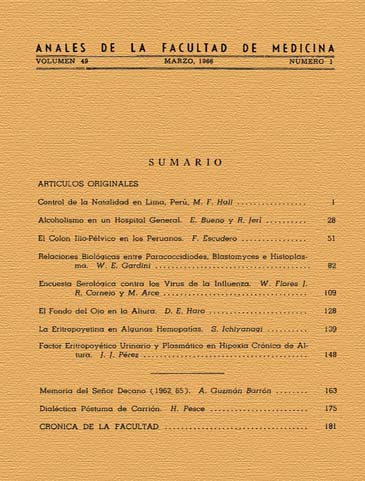Birth Control in Lima, Peru
DOI:
https://doi.org/10.15381/anales.v49i1.5560Abstract
It was carried out a case study of pregnancies and contraceptive methods used by a random sample of 500 women in Lima, Peru . During the five years preceding the interview, the proportion of pregnancies ending in abortions was 19 , 20 and 15 % in the socio- economic middle and lower respectively upper levels . Although the percentage of induced abortions was admitted as low , the rate of abortions was considered relatively high , and it was thought that probably included many whose provocation induced abortions but was not admitted . The suspicions were substantiated when abortions rates were tabulated by age of women and pregnancy order . It can be concluded that induced abortions are a method of controlling fertility in Lima, especially in the high and middle socio- economic levels, and women over 30 who already have 3 or 4 children , are which mainly resort to induced abortions . We found that contraceptive methods were widely practiced , especially the socio- economic upper and middle groups. The proportion of women at risk of pregnancy who were using a contraceptive method at the time the interview was conducted was 68 , 55 and 38% in the high , middle and lower socioeconomic groups respectively . The condom was one of the two most popular contraceptive methods in the three social classes . In the upper and middle socio- economic levels, the rhythm method was also popular, while douching and withdrawal were also popular in the lower level. In all groups , the majority of women were in favor of limiting the family.Downloads
Published
1966-03-14
Issue
Section
Trabajos originales
License
Copyright (c) 1966 M. Francoise Hall

This work is licensed under a Creative Commons Attribution-NonCommercial-ShareAlike 4.0 International License.
Those authors who have publications with this magazine accept the following terms:
- Authors will retain their copyrights and guarantee the journal the right of first publication of their work, which will be simultaneously subject to Creative Commons Attribution License that allows third parties to share the work as long as its author and its first publication this magazine are indicated.
- Authors may adopt other non-exclusive licensing agreements for the distribution of the version of the published work (eg, deposit it in an institutional electronic file or publish it in a monographic volume) provided that the initial publication in this magazine is indicated.
- Authors are allowed and recommended to disseminate their work over the Internet (eg: in institutional telematic archives or on their website) before and during the submission process, which It can produce interesting exchanges and increase quotes from the published work. (See El efecto del acceso abierto ).
How to Cite
1.
Hall MF. Birth Control in Lima, Peru. An Fac med [Internet]. 1966 Mar. 14 [cited 2025 May 23];49(1):1-27. Available from: https://revistasinvestigacion.unmsm.edu.pe/index.php/anales/article/view/5560



